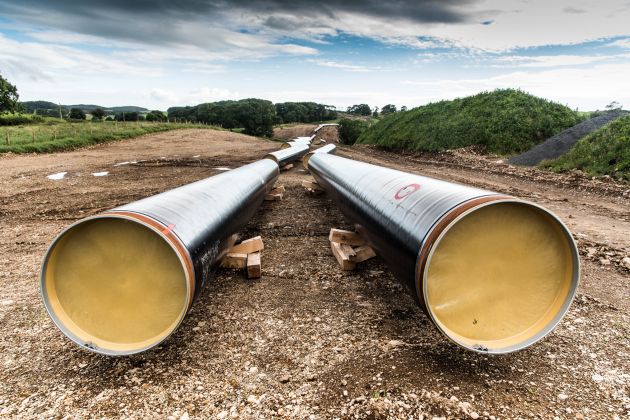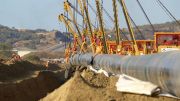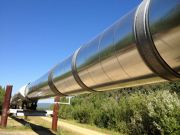-
 Greek entrepreneurship by numbers: Micro-scale and macro impact
Greek entrepreneurship by numbers: Micro-scale and macro impact
-
 Concerns about insipid public consultation process highlighted by treatment of climate plan
Concerns about insipid public consultation process highlighted by treatment of climate plan
-
 Great Expectations: Is Greece 2.0 hitting the target?
Great Expectations: Is Greece 2.0 hitting the target?
-
 Record year for Greek tourism raises concerns about sustainability
Record year for Greek tourism raises concerns about sustainability
-
 What is driving the Greek housing market's recovery?
What is driving the Greek housing market's recovery?
-
 Record FDI flow into Greece raises bar, but is it sustainable?
Record FDI flow into Greece raises bar, but is it sustainable?
EastMed pipeline close to high-level agreement, but still a long way from becoming reality

The EastMed pipeline project is approaching another milestone, with a summit due to take place between Israel, Cyprus and Greece in Jerusalem on March 20.
However, the 6.2-billion-euro energy mega-project still has a number of hurdles to clear before it can become a reality, among them challenges that some consider insurmountable.
The difficulties in bringing the project to fruition were underlined when the intended outcome of the summit was downgraded, from signing an intergovernmental agreement on the pipeline to issuing a statement of intent. The change came about because the fourth partner to the project, Italy, is facing internal opposition to its construction. And that is not the only problem besetting the pipeline.
Since the discovery of major natural gas reserves in the Levantine basin in the past decade, political momentum behind building a gas pipeline connecting the newly-found offshore fields to the markets of mainland Europe has been building.
The plan envisages a pipeline stretching over 2,000 kilometres, from 170 kilometres off the southern coast of Cyprus, via Crete and the Peloponnese, to Otranto on Italy’s eastern coast, delivering up to 20 billion cubic metres per year of natural gas into the European grid.
A number of international agreements have been signed in support of the project, culminating in a summit between Israel, Greece and Cyprus in December 2018 at the Israeli city of Beer-Sheva at which the three countries confirmed that they were ready to proceed, pending approval from the European Commission.
|
Gas field |
Gross mean resources (Bcm) |
Discovery |
|
Tamar - Israel |
280 |
2009 |
|
Leviathan - Israel |
620 |
2010 |
|
Aphrodite - Cyprus |
140 |
2011 |
|
Zohr - Egypt |
850 |
2015 |
|
Glaucus - Cyprus |
142-227* |
2019 |
|
*estimated |
||
|
Source: Tagliapetra 2017, Exxon-Mobil |
||
The recent announcement by Exxon-Mobil of a new discovery offshore Cyprus has boosted optimism around the project, however the challenges to its realisation are long-standing and well-known.
Regional geopolitics
If completed, the EastMed would be among the longest undersea pipelines in the world, as well as the deepest, reaching a depth of 3,300 metres. It is not only engineering records that will be broken with its completion. As repeated statements made by its political backers make clear, it carries the weight of expectations for peace and prosperity in one of the world’s most unsettled regions.
To date, the promise of hydrocarbon-induced geopolitical stability seems to have got some previously unlikely parties around the negotiating table, but the outcome is not a foregone conclusion.
In the first instance, the EastMed is not the only game in town. Almost all parties to the EastMed project are also backing parallel export projects, either because of competing national, political or commercial interests, or as an explicit hedge against the risk of EastMed not materialising.
Israel, which was only two years ago pursuing an export route to Turkey, recently agreed to start selling gas to Egypt as well as Jordan. Cyprus is still backing the building of an LNG terminal at Vassilikos as a “national strategic priority” in the words of President Anastasiades, while it also recently signed an agreement with Egypt for a sub-sea pipeline from the offshore Aphrodite field to Egypt.
Most producer countries also need serve their domestic markets, which even in countries with large reserves such as Egypt could absorb large portions of production. Greece, as a transit country, is already at the crossroads of a number of major energy infrastructure projects, including pipelines and LNG terminals, which would see the country benefit whatever the outcome for the EastMed pipeline.
A major step towards broadening regional energy cooperation was taken in January 2018, when the Eastern Mediterranean Gas Forum was created, bringing together the three participant countries in EastMed with Egypt, Jordan and the Palestinian Authority.
This partnership is significant because it signals Israel’s abandonment of its earlier rapprochement with Turkey. While Egypt is currently a gas importer, one of the biggest recent discoveries, the Zohr field, is located in its territorial waters.
It is also important to note that Egypt already has substantial under-utilised LNG export infrastructure, limiting the need for further investment in transport, and harbours ambitions of becoming a regional gas hub. Therefore, the broader eastern Mediterranean partnership may not intrinsically favour the EastMed project, although it may prove a good test-bed for energy cooperation.
However, in a region with such complex and shifting geopolitics, it is not surprising that cooperation is not in the air in all quarters. Just as the prospect of an eastern Mediterranean gas hub has brought Israel closer to Egypt and Jordan, hydrocarbon exploration and talk of undersea pipelines has heightened territorial disputes between Turkey and its neighbours, Cyprus and Greece.
A pre-announcement of the Glaucus discovery offshore Cyprus prompted Turkish foreign minister, Mevlüt Çavuşoğlu, to warn that “nothing can be done in the Mediterranean without Turkey,” and indeed exploration and extraction in the disputed seabed has been beset by delays thanks to Turkish intervention. This is far from the hope voiced with the first discoveries in the region, that the boom could help reunify Cyprus, which has been separated since the invasion by Turkish forces in 1974.
The practical impact that territorial disputes can have on offshore projects was demonstrated when Eni was blocked from exploring offshore Cyprus by aggressive manoeuvres by the Turkish navy. In a move heavy in signalling, Turkey will also be holding a naval exercise to coincide with the Jerusalem summit in Cyprus’s exclusive economic zone. While energy majors are comfortable with taking a small risk with exploration, the much higher cost and time commitment of building a pipeline in the same disputed waters understandably gives them pause.
European politics
The gas discoveries in the eastern Mediterranean seemed to arrive as the answer to the EU’s prayers, just as concern over Russian dominance of its gas supplies was heightened by the emerging crisis in the Ukraine.
However, the EU, as political sponsor of the project and prospective buyer of its product, may not be able to maintain the same level of commitment going forward. This year’s European Parliament elections and the ushering in of a new Commission could give greater say to nationalist Eurosceptical voices, with an anti-integrationist and potentially more Russia-friendly bent. Such a shift could remove some of the urgency to diversify gas supplies away from Russia, which has been driving the EastMed agenda, and lessen the enthusiasm for joint energy projects in general.
It is also worth noting that – despite the hype - at full capacity the EastMed would only meet around 4 percent of the EU’s gas consumption, which is also expected to decline year on year after 2025. With alternative supply routes such as the TAP pipeline about to come on stream serving the same region, the urgency behind another mega-project may start to flag for more pragmatic reasons.
Climate change and environmental concerns also run counter to large fossil fuel projects like the EastMed pipeline. This opposition has manifested itself at various levels in Europe in recent months. In Italy, the Five Star Movement organised protests against the construction of a terminal for the Trans Adriatic Pipeline (TAP) while in opposition, and once in government only backed down only under the threat of financial sanctions stemming from the construction agreement.
It is internal political pressure that has caused the Italian coalition government to hit the pause button on the project just short of the signing, and order a new environmental impact assessment.
There were also formal protests against the European Investment Bank granting a 1.5 billion-euro loan for the construction of the TAP and TANAP pipelines, on the basis that they contravene EU climate change policies. Support for climate change mitigation remains strong, with the EU parliament recently voting for a legally binding target to use 32 percent of energy from renewable sources by 2030, while also increasing targets for energy saving. Continued pressure in this direction inevitably imposes a use-by date within the next two or three decades on fossil fuel infrastructure such as the EastMed. Ultimately, this makes major investments less commercially attractive.
Political encouragement for regional energy cooperation has also come from the United States. It was recently announced that Secretary of State Mike Pompeo will be attending the March 20 trilateral summit for the EastMed, while the Beer-Sheva summit was attended by the U.S. ambassador to Israel, who declared his country’s full support for the pipeline, since it “aims to diversify energy sources in the area and ensure energy security in Europe.”
The US has several commercial interests in the different parts of the region’s energy puzzle, with some American companies involved in the exploration and exploitation of Levantine gas fields, while others are engaged in shipping shale gas in the form of LNG into the region.
From a geopolitical perspective, an eastern Mediterranean energy hub which excludes Turkey also addresses concerns about the strengthening alliance between Turkey and Russia, while also keeping potential Iranian influence in check. Pompeo’s presence at the Jerusalem summit is interpreted as a strong statement of support from the US for an energy alliance in the region, in the face of Turkish aggression.
However, US support is not focussed exclusively on the EastMed. While supporting regional energy cooperation among its allies, the American stance seems agnostic with regard to competing projects, a position epitomised by the recent statement of US ambassador to Greece, Geoffrey Pyatt, that “the market is going to decide whether the pipeline is constructed.”
Economics
The vocal political backing for the project stands almost in inverse proportion to its economic rationale. While an EU-funded preliminary study has deemed the pipeline economically viable, it is certainly not the most economic option for exporting gas from the region, as a recent study of the various scenarios for the European Parliament concluded.
The inclusion of the EastMed in the EU’s Projects of Common Interest (PCI) is a tacit acknowledgement that its strategic importance for the EU necessitates exceptional levels political support, as well as funding assistance. However, the lion’s share of funding for construction will ultimately have to come from the private sector. To date, private sector enthusiasm for funding the project has been limited, and experts have repeatedly questioned whether the size of the confirmed reserves available for export justifies the high cost of construction.
By backing the EastMed, the emerging gas exporters of the Levantine basin are choosing in effect to bypass a major market on their doorstep – Turkey, a country with negligible domestic production, which has invested massively in gasification of its power supply and the domestic sector, and with a number of long term supply contracts approaching expiry – in favour of the harder-to-reach European Union. They are also potentially ignoring a more cost-effective solution for transporting the gas to the European (and indeed global) markets, in the form of existing LNG infrastructure in Egypt.
Another EU pipe dream?
Despite the political exuberance surrounding it, the cost and complications involved in building the EastMed pipeline put a serious question mark over its economic feasibility, let alone its capacity to heal decades-old geopolitical rifts.
The “pipeline diplomacy” being pursued around the project appears to be having some positive spill-over effects on broader economic cooperation in the region, in areas such as tourism and shipping. While this does not necessarily make it any more likely that the flagship project itself will come to fruition, it could prove beneficial for the region over the long term.
 Greece as an energy hub: Reality or wishful thinking?
Greece as an energy hub: Reality or wishful thinking?  Energy, defence high on agenda as Tsipras prepares for US visit
Energy, defence high on agenda as Tsipras prepares for US visit  Grand projects and even loftier ambitions drive Greece's energy project bonanza
Grand projects and even loftier ambitions drive Greece's energy project bonanza